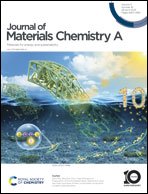A recrystallization approach to repairing spent LiFePO4 black mass†
Abstract
Broad applications of lithium-ion batteries in the past decade have resulted in gigawatt-hours of spent batteries that perplex the recycling industry, especially for the industrially collected spent LiFePO4 (LFP) cathode powders with binders, carbon, and electrolyte residues (“black mass”). Traditional pyrometallurgical/hydrometallurgical recycling as well as direct regeneration via annealing cost too much time and energy. Thermodynamically FePO4, the main de-lithiated product that needs to be repaired in the spent LFP, constitutes only a small portion of the black mass. Thus the energy-consuming long annealing process (600–750 °C in 4–12 h in N2) seems quite unnecessary. Herein, we propose a facile recrystallization approach by reacting black mass with LiNO3. Benefiting from the thermodynamic instability and low melting point (∼250 °C) of LiNO3, the spent LFP can be fully re-lithiated after 30 min of heating at 300 °C in air (right below the LFP oxidation temperature). The specific capacity of the repaired LFP was recovered to 162 mA h g−1 from 134 mA h g−1 with improved rate and cycling performance, competitive with the commercially available new LFP. Ecological and economic assessment of this recycling strategy reveals significantly lower CO2 emission (0.93 kg/kg LFP) and cost ($2270 per t) thanks to the efficient reaction process, significantly lower than that of other direct recycling methods (2–4 kg/kg LFP, >$3000 per t).



 Please wait while we load your content...
Please wait while we load your content...